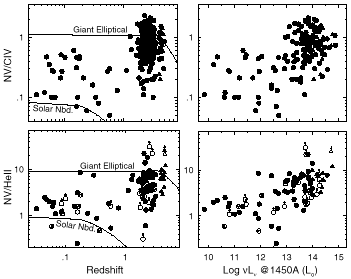


4.2. Ratios Involving NV  1240
1240
Some early studies of the permitted BELs noted that
NV  1240 was significantly
stronger than the predictions of photoionization models
(Osmer & Smith 1976,
1977).
They noted that this NV enhancement might be
due to a nitrogen enhancement as discussed by Shields
(1976,
Section 4.1). More recently,
HF93a,
Ferland et
al. (1996) and
Hamann et al. (1997a)
performed extensive analysis
of the NV
1240 was significantly
stronger than the predictions of photoionization models
(Osmer & Smith 1976,
1977).
They noted that this NV enhancement might be
due to a nitrogen enhancement as discussed by Shields
(1976,
Section 4.1). More recently,
HF93a,
Ferland et
al. (1996) and
Hamann et al. (1997a)
performed extensive analysis
of the NV  1240 emission
compared to CIV
1240 emission
compared to CIV  1549
and HeII
1549
and HeII  1640 for estimating
N/He and N/C abundances.
The NV/CIV line ratio is advantageous in low signal-to-noise
spectra because CIV is essentially always present. The
disadvantage of this ratio is that the NV and CIV line-forming
regions are not quite coincident. The
NV/HeII ratio can be harder to measure because HeII is weak, but
upper limits on HeII still provide useful lower limits on the N/He
abundance. NV/HeII is a more robust abundance indicator
because the NV emitting region lies within the He++ zone, where
HeII
1640 for estimating
N/He and N/C abundances.
The NV/CIV line ratio is advantageous in low signal-to-noise
spectra because CIV is essentially always present. The
disadvantage of this ratio is that the NV and CIV line-forming
regions are not quite coincident. The
NV/HeII ratio can be harder to measure because HeII is weak, but
upper limits on HeII still provide useful lower limits on the N/He
abundance. NV/HeII is a more robust abundance indicator
because the NV emitting region lies within the He++ zone, where
HeII  1640 forms by
recombination. If N+4 does not fill the
He++ zone the NV emission can be weak, but it is not possible to
produce NV without also producing HeII (see also
HF99 for more
discussion).
1640 forms by
recombination. If N+4 does not fill the
He++ zone the NV emission can be weak, but it is not possible to
produce NV without also producing HeII (see also
HF99 for more
discussion).
We studied the theoretical NV/HeII and NV/CIV ratios for a wide
variety of ionizing continuum shapes and BELR parameters.
We used parameters that maximize (or nearly maximize) these
ratios for comparisons to the data,
so that we are most likely to underestimate
the N/He and N/C abundances and thus the overall metallicity.
Figure 3 compares the theoretical predictions to
line ratios measured
in QSOs at different redshifts. The predictions
use abundances from Figure 2,
a BELR density of 1010 cm-3, an incident flux of
hydrogen-ionizing photons of 1020 cm-2
s-1, and
the QSO continuum derived by Mathews and Ferland
(1987;
which we altered slightly to have
 ox = -1.24 and an
additional decline at
wavelengths
ox = -1.24 and an
additional decline at
wavelengths  1
µm).
This continuum shape produces large but not
quite maximum NV line ratios. See
HF93a,
Ferland et al. (1996)
and Hamann et
al. (1997a)
for details on the calculations and the
data set. The evolutionary ages from
Figure 2 are converted to
redshifts assuming the evolution
begins at the Big Bang in a cosmology with
1
µm).
This continuum shape produces large but not
quite maximum NV line ratios. See
HF93a,
Ferland et al. (1996)
and Hamann et
al. (1997a)
for details on the calculations and the
data set. The evolutionary ages from
Figure 2 are converted to
redshifts assuming the evolution
begins at the Big Bang in a cosmology with  M = 1,
M = 1,

 = 0 and
H0 = 65 km s-1 Mpc-1.
The results in Figure 3 show that the short
timescales, flatter IMF (favoring high-mass stars) and higher Z's
in the Giant Elliptical model provide a much better fit to the high-redshift
data. Steeper IMFs (more like the Solar
Neighborhood case) could account for some of the smaller
line ratios if the evolution times are short enough.
The largest line ratios at high redshifts
could be fit by invoking BELR parameters that better optimize
the NV emission or by using still-flatter IMFs.
= 0 and
H0 = 65 km s-1 Mpc-1.
The results in Figure 3 show that the short
timescales, flatter IMF (favoring high-mass stars) and higher Z's
in the Giant Elliptical model provide a much better fit to the high-redshift
data. Steeper IMFs (more like the Solar
Neighborhood case) could account for some of the smaller
line ratios if the evolution times are short enough.
The largest line ratios at high redshifts
could be fit by invoking BELR parameters that better optimize
the NV emission or by using still-flatter IMFs.

|
Figure 3. Observed and predicted NV/CIV and
NV/HeII line ratios versus redshift (left panels) and luminosity
(right panels) for a cosmology with |
One important empirical result is that the NV line ratios are typically larger in more luminous QSOs (HF93a, Osmer et al. 1994, Laor et al. 1995, Véron-Cetty et al. 1983). This trend could be affected by relationships between the luminosity L and various physical parameters of the BELR; however, the trend in the NV line ratios could also result entirely from higher metallicities (and higher relative N abundances) in more luminous sources (also Korista et al. 1998 and this volume). If QSO luminosities correlate positively with the masses of the QSOs and/or their host galaxies (McLeod & Rieke 1995, Magorrian et al. 1998), a metallicity-L relationship would indicate that there is a mass-metallicity relation among QSOs that is similar (or identical) to the well known relation in nearby galaxies (Section 2.2). The fact that high Z's occur only at high redshifts (Fig. 3) might result from the natural tendency to form denser or more massive systems at early epochs, when the mean density of the Universe was itself higher (Haehnelt & Rees 1993).